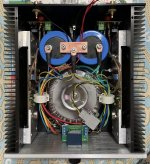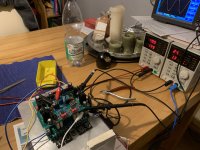A particular type of tube FET.... requires an incandescent light and camera with poor white balance capabilities.
RMI-FC100 with PGA Pre, still too hard to beat…

Last edited:
RMI-FC100 with PGA Pre, still too hard to beat…
View attachment 1111389
Where can I find such boxes?
If I'm not mistaken that is modushop enclosure, just google it, I think they have been in diyaudiostore for some timeWhere can I find such boxes?
Hi,
here my 2-stage Amplifier: Jfet folded cascode (K170+J74) plus Mosfet output stage.
See pictures finished, during build-up and from development phase.
Attached the measurements. „A“ is with high bias (0.6A/Rail); „AB“ is with low bias (0.2A/Rail). Its in german, but I think its self-explaining. If there are some questions just ask 🙂
Regards,
Jean-Claude

here my 2-stage Amplifier: Jfet folded cascode (K170+J74) plus Mosfet output stage.
See pictures finished, during build-up and from development phase.
Attached the measurements. „A“ is with high bias (0.6A/Rail); „AB“ is with low bias (0.2A/Rail). Its in german, but I think its self-explaining. If there are some questions just ask 🙂
Regards,
Jean-Claude
Attachments
Last edited:
JCN,Hi,
here my 2-stage Amplifier: Jfet folded cascode (K170+J74) plus Mosfet output stage.
Regards,
Jean-Claude
Very nice front panel - different! Did you glue it up yourself or buy the material that way? Very neat internal wiring. Is there an air vent on the bottom panel for the heat sinks?
Bruce
Hi,
here an additional picture where you see a bit more inside:

On the front is the power supply, 330VA, Schottky Rectifier, 2 boards with 16 Elkos 2200uF each. On top is a board with the boosted PS for the input / driver stage.
Then comes a small heatsink for 2 CCS each switchable from out+ and out- to +Ub or -Ub.
Behind is a gap, then the big Amplifier heatsink with the 2 stacked boards on it (voltage amp and output stage). The bottom plate of the housing is split into 2 parts, there is a wide slot in the middle which leaves the fins of all 2 heatsinks completely free.
To 2nd question: For sure I can share the schematic, but unfortunately not today because I have no access to the data at the moment.
Edit: The front panel is a wood called „Baubuche“. The green light is a speciality: The hole for the LED is drilled until 0.5mm to the front so you see only wood when the amp is switched off.
Regards, Jean-Claude
here an additional picture where you see a bit more inside:
On the front is the power supply, 330VA, Schottky Rectifier, 2 boards with 16 Elkos 2200uF each. On top is a board with the boosted PS for the input / driver stage.
Then comes a small heatsink for 2 CCS each switchable from out+ and out- to +Ub or -Ub.
Behind is a gap, then the big Amplifier heatsink with the 2 stacked boards on it (voltage amp and output stage). The bottom plate of the housing is split into 2 parts, there is a wide slot in the middle which leaves the fins of all 2 heatsinks completely free.
To 2nd question: For sure I can share the schematic, but unfortunately not today because I have no access to the data at the moment.
Edit: The front panel is a wood called „Baubuche“. The green light is a speciality: The hole for the LED is drilled until 0.5mm to the front so you see only wood when the amp is switched off.
Regards, Jean-Claude
Hello,
here the schematic from LTSpice. Its not 100% the Eagle schematic, but all important is there.
The 50R in the input stage are a 100R Pot set to center position. There you can adjust harmonics and DC offset.
Regards J-C

here the schematic from LTSpice. Its not 100% the Eagle schematic, but all important is there.
The 50R in the input stage are a 100R Pot set to center position. There you can adjust harmonics and DC offset.
Regards J-C
Oh yeah!!! you triggered me with your info in post #7368. I bet this amp sounds superb.
what is the voltage gain?
what is the voltage gain?
How about LTspice file?😉Hello,
here the schematic from LTSpice. Its not 100% the Eagle schematic, but all important is there.
The 50R in the input stage are a 100R Pot set to center position. There you can adjust harmonics and DC offset.
Regards J-C
View attachment 1114483
Hi!
The amp sounds superb imO. A friend had the strict opinion that he only want tube amps and he never had an sand amp which satisfied him. At the end he beg me that he could have my prototype amp (the one I have shown above) and he is very happy with it.
I wouldnt say it sounds like an tube amp - but very fast / dynamic, no wonder with a slew rate around 200V/us (without input filter).
And since there is only 1 voltage stage there is no dominante pole compensation neccessary and the amp was very gentle during development. In no phase I had trouble with oscillation. Even a 100kHz rectangle comes out very clean.
Gain is set to 20dB (feedback network 68k / 6k8), the measurements above are with OLG of ~54dB. There can be more/less by replacing the load resistors of the folded cascode.
Regarding the LTSpice-Files: Is this the right place here for a detailed discussion or is it a better idea to start a new threat?
I have several versions available: Actually our "amplifier anonymous" group builds 14 Monos of a version with 4 Mosfets in parallel and I have annother input stage without servos (I think they are not neccessary), modified (fully symmetric) reference current source and a Jfet-buffer in front for lower feedback network impedance and therefore lower noise.
Regards, Jean-Claude
The amp sounds superb imO. A friend had the strict opinion that he only want tube amps and he never had an sand amp which satisfied him. At the end he beg me that he could have my prototype amp (the one I have shown above) and he is very happy with it.
I wouldnt say it sounds like an tube amp - but very fast / dynamic, no wonder with a slew rate around 200V/us (without input filter).
And since there is only 1 voltage stage there is no dominante pole compensation neccessary and the amp was very gentle during development. In no phase I had trouble with oscillation. Even a 100kHz rectangle comes out very clean.
Gain is set to 20dB (feedback network 68k / 6k8), the measurements above are with OLG of ~54dB. There can be more/less by replacing the load resistors of the folded cascode.
Regarding the LTSpice-Files: Is this the right place here for a detailed discussion or is it a better idea to start a new threat?
I have several versions available: Actually our "amplifier anonymous" group builds 14 Monos of a version with 4 Mosfets in parallel and I have annother input stage without servos (I think they are not neccessary), modified (fully symmetric) reference current source and a Jfet-buffer in front for lower feedback network impedance and therefore lower noise.
Regards, Jean-Claude
Hi Jean-Claude,Hi!
The amp sounds superb imO. A friend had the strict opinion that he only want tube amps and he never had an sand amp which satisfied him. At the end he beg me that he could have my prototype amp (the one I have shown above) and he is very happy with it.
I wouldnt say it sounds like an tube amp - but very fast / dynamic, no wonder with a slew rate around 200V/us (without input filter).
And since there is only 1 voltage stage there is no dominante pole compensation neccessary and the amp was very gentle during development. In no phase I had trouble with oscillation. Even a 100kHz rectangle comes out very clean.
Gain is set to 20dB (feedback network 68k / 6k8), the measurements above are with OLG of ~54dB. There can be more/less by replacing the load resistors of the folded cascode.
Regarding the LTSpice-Files: Is this the right place here for a detailed discussion or is it a better idea to start a new threat?
I have several versions available: Actually our "amplifier anonymous" group builds 14 Monos of a version with 4 Mosfets in parallel and I have annother input stage without servos (I think they are not neccessary), modified (fully symmetric) reference current source and a Jfet-buffer in front for lower feedback network impedance and therefore lower noise.
Regards, Jean-Claude
You can start a new thread if you like. It is good amp with some good ideas.
Only thing where I see the problem is unattainable or to expasive jfets.
BR Damir
SX 15W Class A with porous ceramic heatsinks. Smaller and lighter. Details in SS amps.

WoW, first time I see an oscilloscope on an audio tuner!🤔
Extract of manual: »….
OSCILLOSCOPE
The Cathode Ray Tube, also referred to as an oscilloscope, is the only vacuum tube in the Model 2130. It provides a visual display permit-
ting accurate tuning, accurate antenna alignment
for minimal multipath distortion, and an evalua- tion of stereo programs as to stereo separation… »
Fab
Extract of manual: »….
OSCILLOSCOPE
The Cathode Ray Tube, also referred to as an oscilloscope, is the only vacuum tube in the Model 2130. It provides a visual display permit-
ting accurate tuning, accurate antenna alignment
for minimal multipath distortion, and an evalua- tion of stereo programs as to stereo separation… »
Fab
- Home
- Amplifiers
- Solid State
- Post your Solid State pics here




